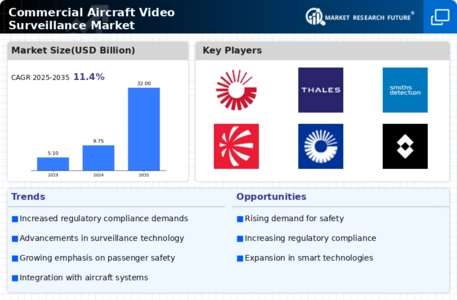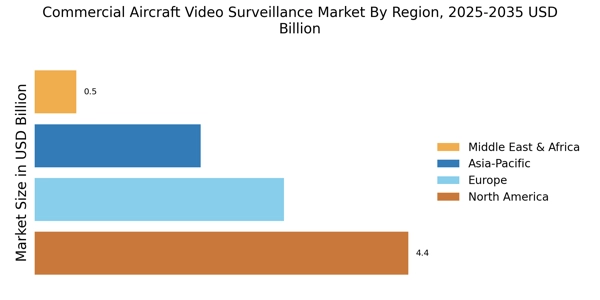Emerging Markets and Airline Expansion
Emerging markets are playing a crucial role in the growth of the Commercial Aircraft Video Surveillance Market. As airlines expand their operations into new regions, there is a heightened need for effective surveillance systems to ensure safety and security. These markets often face unique challenges, including varying regulatory environments and security threats, which necessitate tailored surveillance solutions. The expansion of airlines into these regions is likely to drive demand for advanced video surveillance technologies, as operators seek to establish secure and efficient operations. Consequently, the market is expected to experience significant growth as airlines adapt to the complexities of operating in diverse environments.
Increased Investment in Aviation Security
The Commercial Aircraft Video Surveillance Market is benefiting from increased investment in aviation security. Governments and private entities are allocating substantial resources to enhance security measures at airports and onboard aircraft. This investment is driven by the need to address emerging threats and ensure the safety of air travel. As a result, the demand for sophisticated video surveillance systems is on the rise, with airlines seeking to implement cutting-edge technologies that provide comprehensive monitoring capabilities. The market is anticipated to grow as stakeholders recognize the importance of robust security measures in maintaining public confidence in air travel.
Focus on Passenger Experience and Security
In the Commercial Aircraft Video Surveillance Market, there is a growing emphasis on enhancing passenger experience while ensuring security. Airlines are increasingly recognizing that a secure environment contributes to passenger satisfaction. The integration of video surveillance systems allows for better monitoring of passenger behavior, which can lead to improved service delivery and a more pleasant travel experience. This dual focus on security and passenger comfort is likely to drive the adoption of advanced surveillance technologies. As airlines invest in these systems, the market is expected to witness a steady increase in demand, reflecting the industry's commitment to balancing safety with customer satisfaction.
Regulatory Compliance and Safety Standards
Regulatory compliance plays a pivotal role in shaping the Commercial Aircraft Video Surveillance Market. Governments and aviation authorities are imposing stringent regulations regarding passenger safety and security, necessitating the implementation of advanced surveillance systems. Compliance with these regulations not only ensures the safety of passengers but also protects airlines from potential legal liabilities. The market is likely to see an increase in demand for surveillance solutions that meet these regulatory standards, as airlines strive to enhance their security protocols. As a result, the market is projected to expand, driven by the need for compliance with evolving safety regulations and standards.
Technological Advancements in Surveillance Systems
The Commercial Aircraft Video Surveillance Market is experiencing a surge in technological advancements, particularly in high-definition video capture and real-time data analytics. Innovations such as AI-driven analytics and enhanced image processing capabilities are becoming increasingly prevalent. These technologies not only improve the quality of surveillance footage but also enable airlines to monitor passenger behavior and cabin conditions more effectively. The integration of advanced surveillance systems is projected to enhance operational efficiency and safety, with the market expected to grow at a compound annual growth rate of approximately 7% over the next five years. This growth is indicative of the industry's commitment to leveraging technology for improved security and operational oversight.


















Leave a Comment